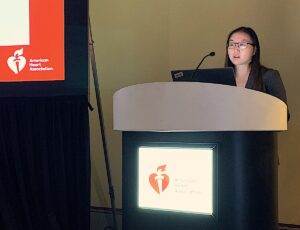Kaiser Permanente study presented at American Heart Association meeting focused on girls with polycystic ovary syndrome
Teenage girls with polycystic ovary syndrome, a reproductive health condition associated with menstrual irregularity, had a 30% higher risk of having high blood pressure than girls without the condition, Kaiser Permanente researchers reported on November 13 at the American Heart Association Scientific Sessions meeting.
The study was presented during a session focused on female-specific factors for cardiovascular disease.

“We’ve known for some time that adult women with polycystic ovary syndrome are more likely to have hypertension and other cardiovascular risk factors,” said the study’s senior author Joan C. Lo, MD, a research scientist at the Kaiser Permanente Northern California Division of Research and a physician with The Permanente Medical Group. “Our study found that this increased risk of elevated blood pressure — which is a risk factor for cardiometabolic diseases, such as heart attack, stroke, and diabetes — is also seen in teenage girls.”
The study included 168,793 girls ages 13 to 17 who were members of Kaiser Permanent Northern California between 2012 to 2018. Within this group, 1,142 girls were diagnosed with polycystic ovary syndrome. Importantly, the young women represented a diverse population: about 34% were white, about 30% were Latina; about 20% were Asian/Pacific Islander, and nearly 10% were Black.

The researchers found that 18.6% of the girls with polycystic ovary syndrome had blood pressure readings in the hypertension range, compared to 6.9% of the girls who did not have the syndrome. High blood pressure was defined as a reading greater than 130/80 mmHg. After accounting for age, race and ethnicity, and weight category of the girls, the analysis found that having polycystic ovary syndrome was associated with a 30% higher risk of a girl having hypertensive blood pressure.
“Studying adolescents allows us to better identify possible cardiometabolic complications of polycystic ovary syndrome that may develop at a young age in hopes of reducing future cardiovascular risk,” lead study author Sherry Zhang, MD, a resident physician in internal medicine at Kaiser Permanente Oakland Medical Center in Oakland, told the audience. “These findings underscore the importance of routine blood pressure monitoring for all adolescents.”
Among the girls studied, nearly 66% were healthy weight, nearly 19% were overweight, and more than 15% were obese. About 75% of the girls had normal blood pressure (less than 120/80 mmHg); 17.5% had elevated blood pressure (120-129/less than 80 mmHg); and 6.9% had a hypertensive blood pressure. All of the girls with polycystic ovary syndrome had been diagnosed within a year of the well-child visit where their blood pressure had been measured.
 Polycystic ovary syndrome is a reproductive health condition seen in females of childbearing age. Studies suggest about 1 in 10 women have the syndrome, which can affect ovulation, raise androgen levels, and cause cystic changes in the ovaries. It also can cause excess hair growth, acne, infertility, and weight gain.
Polycystic ovary syndrome is a reproductive health condition seen in females of childbearing age. Studies suggest about 1 in 10 women have the syndrome, which can affect ovulation, raise androgen levels, and cause cystic changes in the ovaries. It also can cause excess hair growth, acne, infertility, and weight gain.
“Our findings emphasize the need for primary care providers to be aware that the cardiometabolic effects of polycystic ovary syndrome are seen in young women, and that young women with the condition should be routinely screened for high blood pressure,” said Lo. “Those who are found to have high blood pressure should be encouraged to make lifestyle modifications — such as improving their diet and getting more exercise — that can help reduce risk for cardiovascular disease.”
The researchers said they intend to continue additional studies on cardiovascular risk factors in adolescent girls. “We want to see if teenage girls with polycystic ovary syndrome continue to have high blood pressure as they get older and how this condition relates to other cardiometabolic risk factors they currently have or develop,” said Lo.
Co-authors include Jeanne Darbinian, MS, MPH, of the Division of Research; and Louise Greenspan, MD, and Sahar Naderi, MD, of The Permanente Medical Group.
# # #
About the Kaiser Permanente Division of Research
The Kaiser Permanente Division of Research conducts, publishes and disseminates epidemiologic and health services research to improve the health and medical care of Kaiser Permanente members and society at large. It seeks to understand the determinants of illness and well-being, and to improve the quality and cost-effectiveness of health care. Currently, DOR’s 600-plus staff is working on more than 450 epidemiological and health services research projects. For more information, visit divisionofresearch.kaiserpermanente.org or follow us @KPDOR.





Comments (0)